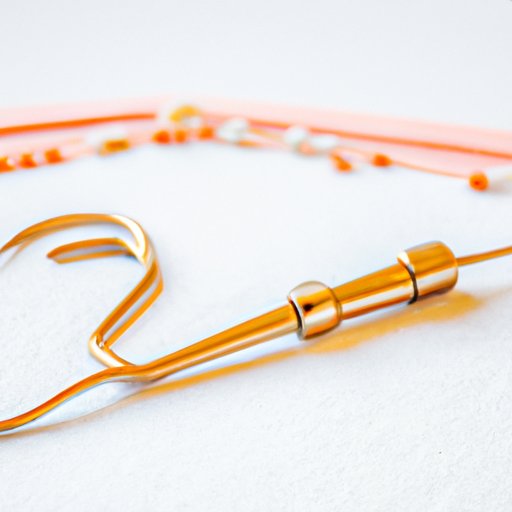Introduction
Intrauterine devices (IUDs) are small, T-shaped contraceptive devices that are inserted into the uterus to prevent pregnancy. An IUD is a safe, long-acting, and reversible form of birth control that can be used by women of all ages. Depending on the type of IUD, it can last for up to 10 years and can be removed at any time.
There are two main types of IUDs: hormonal IUDs and copper IUDs. Hormonal IUDs release a synthetic form of the hormone progestin, which prevents pregnancy by thickening the cervical mucus and thinning the lining of the uterus. Copper IUDs, on the other hand, contain copper wire spirals that create an inflammatory reaction in the uterus, which makes it difficult for sperm to reach and fertilize an egg.
Exploring the Different Types of IUDs and How They Work
Hormonal IUDs are designed to prevent pregnancy for up to five years after insertion. The most common type of hormonal IUD is Mirena, which releases the hormone levonorgestrel. This hormone helps to thicken cervical mucus, making it more difficult for sperm to reach and fertilize an egg. It also works to make the lining of the uterus thinner, which can prevent implantation of a fertilized egg.
The second type of IUD is the copper IUD, which does not contain hormones. Instead, it contains copper wire spirals that create an inflammatory response in the uterus, making it difficult for sperm to reach and fertilize an egg. Copper IUDs can last for up to 10 years and do not require regular maintenance.

A Comprehensive Guide to Understanding How IUDs Function
To understand how IUDs work, it’s important to first understand the science behind them. IUDs are designed to prevent pregnancy by interfering with the normal process of conception. In order for a woman to become pregnant, sperm must swim through the cervix and uterus to reach and fertilize an egg. IUDs interfere with this process by either preventing sperm from entering the uterus or preventing a fertilized egg from implanting in the uterus.
Hormonal IUDs work by releasing a synthetic form of the hormone progestin, which thickens the cervical mucus and thins the lining of the uterus. This makes it difficult for sperm to reach and fertilize an egg. Copper IUDs work differently; they contain copper wire spirals that create an inflammatory response in the uterus, making it difficult for sperm to reach and fertilize an egg.
A Beginner’s Guide to IUDs: How They Protect Against Pregnancy
Before an IUD can be inserted, a medical professional must first evaluate a woman’s medical history and perform a physical exam. During the insertion process, the IUD is placed into the uterus using a speculum and a special applicator. After insertion, a doctor may recommend that the patient wait for a few hours before engaging in sexual activity to reduce the risk of infection.
Once an IUD is in place, it begins to protect against pregnancy immediately. Hormonal IUDs work by preventing ovulation, while copper IUDs work by creating an inflammatory reaction in the uterus that makes it difficult for sperm to reach and fertilize an egg. Both types of IUDs also make it harder for a fertilized egg to implant in the uterus.

An Overview of IUDs: How They Keep You From Getting Pregnant
IUDs are an effective form of birth control, but there are some risks associated with their use. These include pelvic inflammatory disease (PID), perforation of the uterus, and expulsion of the IUD. For this reason, it is important to discuss any potential risks with your doctor before deciding to use an IUD.
In addition to preventing pregnancy, IUDs have several other benefits. They are discreet, convenient, and cost-effective forms of birth control. They also do not interfere with sexual activity and can be used safely by women of all ages.
Conclusion
IUDs are a safe, effective, and long-lasting form of birth control. They come in two main varieties: hormonal IUDs and copper IUDs. Hormonal IUDs work by releasing a synthetic form of the hormone progestin, which thickens cervical mucus and thins the lining of the uterus. Copper IUDs contain copper wire spirals that create an inflammatory reaction in the uterus, making it difficult for sperm to reach and fertilize an egg. Both types of IUDs can be inserted into the uterus by a medical professional and provide immediate protection against pregnancy.
Although IUDs are generally safe and effective, there are some risks associated with their use. It is important to discuss any potential risks with your doctor before deciding to use an IUD. With the right information and support, IUDs can be a great option for women looking for long-term birth control.
(Note: Is this article not meeting your expectations? Do you have knowledge or insights to share? Unlock new opportunities and expand your reach by joining our authors team. Click Registration to join us and share your expertise with our readers.)
